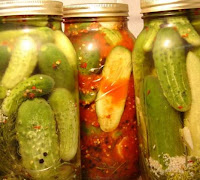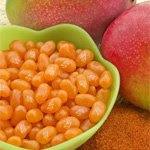Date: June 24, 2009
Cheese
Block Cheese steady "The CME Group cash cheese market was weak and Friday prices closed below a week ago. Both block and barrel prices are again below the dairy product support prices of $1.10 per pound for barrels and $1.13 for blocks. Cheese production and offerings remain heavy with most manufacturing plants operating on extended schedules to clear the milk supplies. Retail promotions continue to stimulate sales in selected markets. Wet, cool weather has hurt food service orders from some summer vacation locations.
locations..(Source: USDA Dairy Market News, Week of June 15-19, 2009) "
Butter AA steady "Cash butter pricing at the CME continues to edge lower and closed the week at $1.2050. On Monday, June 15, the Kansas City Commodity Office announced that all of the butter that was purchased under the dairy support program earlier in the year, 4,639,010 pounds, was sold back to the trade under invitation #1. Prices for this sellback ranged from $1.1581 - 1.1750 per pound and averaged $1.1641 per pound. Current churning schedules across the country are seasonally active, although trending lower as cream volumes become more competitive. Many butter producers continue to indicate that current churning is often heavier than demand, thus surplus volumes are clearing to inventory for future use, although these inventory clearances are declining. Butter demand is light to fair and most often at expected levels.Source: USDA Dairy Market News, Week of June 15-19, 2009)
Poultry -
Georgia Dock steady Effects of grilled chicken intro. Starting to wind down. Should be near the peak price.
NE Boneless Breast steady Should see some retail focus next week. Should be steady this week then trending up.
NE Select Boneless Breast steady Should see some retail focus next week. Should be steady this week then trending up.
NE Wings steady Continued steady demand and constrained supply will not let this market drop. At or near the low. Should see prices move up later in the summer from this point.
NE Jumbo Wings steady Continued steady demand and constrained supply will not let this market drop. At or near the low. Should see prices move up later in the summer from this point.
NE Tenders steady Becuase of limited food service demand this market is moving on bonless breast substitution. As boneless breast goes so will will this market keeping a similar gap in pricing.
NE Small Tenders steady Becuase of limited food service demand this market is moving on bonless breast substitution. As boneless breast goes so will will this market keeping a similar gap in pricing.
NE Boneless Thigh Meat Special Trim steady As exports rise and falls, this item will do likewise as leg quarters are sent overseas versus deboned for domestic use.
Boxed Beef Boxed Beef Cutout, Choice steady Inexpensive Pork and Chicken is forcing the Beef industry to compete for market share. Price appreciation within the Beef complex is unlikely. Short term market stability driven by the upcoming holiday will offer stablility to the market short term.
Boxed Beef Cutout, Select steady Inexpensive Pork and Chicken is forcing the Beef industry to compete for market share. Price appreciation within the Beef complex is unlikely. Short term market stability driven by the upcoming holiday will offer stablility to the market short term.
81% Lean Fine Ground Beef gradual increase Inexpensive Pork and Chicken has taken market share for the Ground Beef complex which is reflected in the per pound price. Packer have not been able to rally the market. Expect market stability
Inside (Top) Rounds - Commodity Trim, Choice steady Inside Rounds are slowly increasing in value. The price is under valued for this time of the year and will drift higher as middle meat complex depreciatates.
Inside (Top) Rounds - Commodity Trim, Select steady Inside Rounds are slowly increasing in value. The price is under valued for this time of the year and will drift higher as middle meat complex depreciatates.
Heavy Lip On Rib Eyes, Choice steady Seasonal peaks in volume/demand have been achieved but prices are temporialy holding steady to slightly higher in front last minute demand for July 4th.
Heavy Lip On Rib Eyes, Select price increase Seasonal peaks in volume/demand have been achieved but prices are temporialy holding steady to slightly higher in front last minute demand for July 4th.
5/up PSMO Tenderloins, Choice steady Demand for Tenderloins has been surprisingly high which has translated into higher asking prices and unexpected market stability. No change expected during the next 2 weeks.
5/up PSMO Tenderloins, Select steady Demand for Tenderloins has been surprisingly high which has translated into higher asking prices and unexpected market stability. No change expected during the next 2 weeks.
0X1 Strip Loins Boneless Strip Loins, Choice gradual decrease The high point of seasonal demand has now come and gone. Last minute retail interest in USDA Choice Strip Loins should prevent downward price adjustment near term. No Roll Strips Loins however are being discounted.
0X1 Strip Loins Boneless Strip Loins, Select price decrease The high point of seasonal demand has now come and gone. Last minute retail interest in USDA Choice Strip Loins should prevent downward price adjustment near term. No Roll Strips Loins however are being discounted.
Heavy Top Sirloin Butts - Commodity Trim, Choice steady Top Sirloin Butts are a market opportunity which will is reflected in the price. Worth a closer look. Market support or interest in the Top Butt has been limited.
Heavy Top Sirloin Butts - Commodity Trim, Select gradual decrease Top Sirloin Butts are a market opportunity which will is reflected in the price. Worth a closer look. Market support or interest in the Top Butt has been limited.
Tri Tips, Fat On, Choice steady Generally steady into July 4th support by CA retail volume
Tri Tips, Fat On, Select gradual increase Generally steady into July 4th support by CA retail volume
Flap Meat, USDA Choice steady Retail interest in Flap Meat has driven price higher. Market avaialbility from the packers is limited which is justifying the higher price in the mind of the packers
Flap Meat, Select gradual increase Retail interest in Flap Meat has driven price higher. Market avaialbility from the packers is limited which is justifying the higher price in the mind of the packers
2/up Ball Tips, Choice steady Top Butts seem to be a better option in both price and quality short term. The Sirloin is one of the best price values in the Beef complex
2/up Ball Tips, Select gradual decrease Top Butts seem to be a better option in both price and quality short term. The Sirloin is one of the best price values in the Beef complex
Boneless Beef Briskets, Choice 0 0
Boneless Beef Briskets, Select steady The Brisket market remains steady. Like to no downward price adjustment are expected until mid July.
Outside Skirts, Commodity Trim price increase The packers trying to force Outside Skirt prices higher.
Pork Overall category update Cash prices for hogs are stabilizing; Retailers are beginning to feature pork at very competitive prices which should assist in bringing back some of the last domestic demand
Pork Loin Boneless w/Strap steady Boneless loins have been on an up and down trend of late; long term 6-8 week forecasts call for increases on both Strap on & product
Pork Loin Boneless Strap Removed steady Boneless loins have been on an up and down trend of late; long term 6-8 week forecasts call for increases on both Strap on & product
Pork Loin 21dn 1/4 in. lgt Bone In gradual decrease Prices are expected to trade steady this week, move slightly lower next week prior to moving slighltly higher in July; lackluster demand has capped any major seasonal upside potential
Loin Back Ribs steady Prices on back ribs are expected to drop significantly over the next 3-4 weeks
Hams 20/23 gradual decrease Ham values are expected to remain fairly steady with only a slight swing up or down through the remainder of June; $'s are expected to rebound in July
Pork Bellies 14/16 gradual increase Sideways to slightly higher trades are expected through the end of June; $'s are expected to reach their summer high's \by late July/early August
Pork Butts, 1/4 in. trim 5-10# price increase Steady trades are expected this week prior to moves downward next week; mid July prices should rebound to current levels
Spare Ribs price increase Spare rib prices moved considerably higher last week; prices are expected to work slightly higher this week prior to decreasing significantly by mid July
Sow 550 & up price decrease Liquidation appears to be underway as Sow prics have begun to tumble; future declines are expected as demand for Sow based products is non existent
Pork Trimmings 42% (Combo Fresh) #N/A #N/A
Pork Trimmings 72% (Combo Fresh) #N/A #N/A
Beef Trimmings 50% (Combo Fresh) steady Seasonal demand driven by retail should begin push prices higher
Beef Trimmings 90% (Combo Fresh) steady Seasonal demand driven by retail should begin push prices higher
Seafood
Domestic Shrimp steady "The climate in the Gulf region is still dull. Sales are
being characterized as fair, to in some cases moderate, but not near the level
needed to absorb current inventories and anticipated production. As a result,
the HLSO shrimp market ranges barely steady to weak. PUD production is
reportedly in a bit of a lull, but recent and anticipated future production are
weighing on the market."
Mexican Shrimp steady Mexican Shrimp is still on schedule for June harvest of farmed product and August/September for wild harvest. Pricing on current inventories are steady.
Asian Blk Tigers steady "Supplies of 21-25 count and smaller shrimp are limited
although off erings have steadied somewhat. The balance of the HLSO
market is steady."
Vannamei Shrimp (Asian, So Amer,Indian) steady "The farmed white HLSO shrimp market is steady to full steady
at listed levels for a fair demand. Supplies of 41-50 count and smaller shrimp
are fairly tight."
Domestic Catfish steady "Pangasius Frozen Fillets (Vietnam): 5 & up oz. fi llets fi rmed
slightly. The market holds a steady to full steady undertone as
supplies prove to be just adequate at newly quoted levels.
"
Cod steady Cod inventories are very good in all sizes across the board and much more affordable this year than last, and there are still some scattered landings in the Gulf of Alaska.
Pollock steady Pollock fillet and block markets remain strong; inventories of 2/4 fillets are scarce and demand is solid. It's doubtful we will have enough of these to carry us to "B" season. Other sizes will be tight, but supplies should be adequate.
Salmon Wild/Farm Raised gradual increase "ATLANTIC Supply is tightening which has been anticipated for some time. Less fish in general is available from Chile, and fish that is available is smaller than what is normally processed, so the larger sizes of portions (8 & 10 oz) will be the first ones in short supply. Look for the market to continue to tighten through the balance of the year and into 2010. KETA Inventories of 2008 Keta Salmon in China are moving steadily as we approach the start of the 2009 season. It appears there won't be much carryover of Hokkaido Keta from last year to this year. Alaska processors are looking to pre-sell much of the catch to customers requiring MSC certification. The first indications of the catch in Alaska will occur in late June in the Prince William Sound fishery. Preseason forecasts call for a total run slightly higher than 2008. SOCKEYE Extra inventory is becoming available, as Europe’s demand has fallen off slightly. Pricing should begin to soften in the next few months. COHO Inventories are good and prices have stabilized. 2009 production will not be available until August.
"
Crab steady KING CRAB There is still a lot of conflicting information about the spring king crab fishery in the Russian Far East. There has been a lot of recent publicity about efforts in Russia to nationalize the fleet but it is unclear as to exactly when that would happen. There have been some early landings already in the Russian Far East, but again whether the fishery will continue in its normal cycle for the remainder of the season is yet to be seen. In the meantime, the direction of the market is unclear until the supply situation is clarified. SNOW CRAB The catch in Newfoundland through the 21st of May is at 37% of the quota. Pricing has stabilized a bit in the last couple weeks, but still a little unsettled. Some Japanese companies have made commitments however they are quite a bit less, in volume, than last year, in some instances as much as half. Things should be much clearer over the next three weeks or so. DUNGENESS CRAB Inventories are good. Pricing has stabilized, and will move up a little in the coming months as fishing pressure on the coast has diminished and most of the current catch is going live. Next potential product will come from Alaskan Fisheries this summer
Scallops steady "The news from the open areas is that the catch rate continues to be very good. To date, the vast majority of the landings (~80%) are in the 10/20 ct range, with u/10 and 20/30 ct making up the balance of the catch. We anticipate this trend to continue, and the spread in price between u/10 ct and 10/20 ct is expected to persist. Offerings for smaller scallops from South America are exhibiting good value in these sizes, and prices on Bay Scallops remain flat. "
Oil & Shortening Overall category update Oil markets remain down as of 6/22 am as a result of reduced export demand, softer outside markets, and favorable weather/planting conditions. Volatility is likely to remain, however.

 A field melon and of the species Cucumis melo, this Armenian variety has several aliases including Syrian cucumber, Turkish cucumber, Metki melon and snake melon.
A field melon and of the species Cucumis melo, this Armenian variety has several aliases including Syrian cucumber, Turkish cucumber, Metki melon and snake melon.  A field melon and of the species Cucumis melo, this Armenian variety has several aliases including Syrian cucumber, Turkish cucumber, Metki melon and snake melon.
A field melon and of the species Cucumis melo, this Armenian variety has several aliases including Syrian cucumber, Turkish cucumber, Metki melon and snake melon. 













